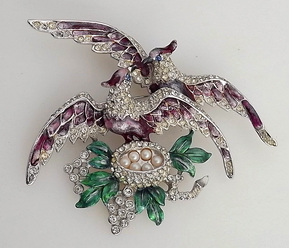Product Description
BOUCHER, MARCEL — 1937-1971/72 (Pronounced: Boo-shay)
PHOTO FOR INFORMATION ONLY

Marcel Boucher was born in Paris in 1898. After WWI he apprenticed as a designer at Cartier, one of France's most prestigious jewelry houses. In the early 1920s, he transferred to Cartier in New York City. During the depression, the demand for fine jewelry waned so Marcel found work at Mazer Bros., jewelers who were experts increating affordable copies of high-end jewelry. He became fascinated with the amazing, limitless, design possibilities, of costume jewelry. In 1937, Marcel and Arthur Halberstadt founded "Marcel Boucher Ltd. Novelty Jewelry," a successful partnership with Marcel in charge of design and manufacturing and Arthur sales and financial operations. In 1944, they changed the company name to "Marcel Boucher & Cie."
Marcel's pieces featured intricate metalwork, gem like rhinestones that resembled precious stones, top-quality imitation pearls, and artistic, colorful, enamel work. These talents, in particular, his spectacular, bold, enameled pieces; brooches shaped like fruits, animals, and human figures, gained him afame and a great following. His beautiful, fantasy bird pieces, were stunning with their bright enamels, richly colored stones, and three-dimensional design. Marcel also loved mechanics and incorporated moving parts into his jewelry. "Punchinello," a court jester, raises his arms and legs when a chain is pulled; a pelican opens his beak to catch a fish; and flower petals open and close in his "Night and Day" flower series.
During World War II, the white metal used in costume jewelry was restricted to military use. Jewelers used sterling silver so Marcel moved to Mexico for the duration of the war to be close to the abundant supply of silver. While there, he created his line, "Parisina," named in honor of his beloved France and the traditional artistry of Mexican silversmiths. at the end of the war Marcel returned to New York City. at that time he experimented with Cubist-inspired pieces and began to produce parures to wear with the newly feminine post-war fashions.
In 1949, Arthur left the business, and Sandra Raymonde Semensohm became Marcel's assistant. Sandra was a well-respected jewelry designer in her own right, and the two became the power couple of costume jewelry. In October 1964, Sandra and Marcel were married, and in January 1965, he died. Sandra ran the company for a few years, but she was more designer than a businessperson. In 1970, she sold the business to Davorn Industries, continuing with the company as a designer of watches, marking them "Marcel Boucher." In 1979, Davorn was sold to D'Orlan Industries of Toronto, who continued to use Marcel's molds. In 1984, D'Orlan partnered with Nina Ricci and remained in business until 2006.








